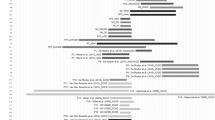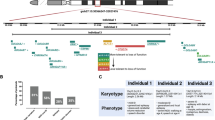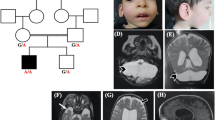Abstract
We describe the detailed clinical and molecular characterization of three patients (aged 7, 84/12 and 31 years) with overlapping microdeletions in 19p13.12, extending to 19p13.13 in two cases. The patients share the following clinical features with a recently reported 10-year-old girl with a 19p13.12 microdeletion: mental retardation (MR), psychomotor and language delay, hearing impairment, brachycephaly, anteverted nares and ear malformations. All patients share a 359-kb deleted region in 19p13.12 harboring six genes (LPHN1, DDX39, CD97, PKN1, PTGER1 and GIPC1), several of which may be MR candidates because of their function and expression pattern. LPHN1 and PKN1 are the most appealing; LPHN1 for its interaction with Shank family proteins, and PKN1 because it is involved in a variety of functions in neurons, including cytoskeletal organization. Haploinsufficiency of GIPC1 may contribute to hearing impairment for its interaction with myosin VI. A behavioral phenotype was observed in all three patients; it was characterized by overactive disorder associated with MR and stereotyped movements (ICD10) in one patient and hyperactivity in the other two. As Ptger1-null mice show behavioral inhibition and impulsive aggression with defective social interaction, PTGER1 haploinsufficiency may be responsible for the behavioral traits observed in these patients.
Similar content being viewed by others
Log in or create a free account to read this content
Gain free access to this article, as well as selected content from this journal and more on nature.com
or
References
Engels H, Brockschmidt A, Hoischen A et al: DNA microarray analysis identifies candidate regions and genes in unexplained mental retardation. Neurology 2007; 68: 743–750.
Jensen DR, Martin DM, Gebarski S et al: A novel chromosome 19p13.12 deletion in a child with multiple congenital anomalies. Am J Med Genet A 2009; 149A: 396–402.
Aten E, den Hollander N, Ruivenkamp C et al: Split hand-foot malformation, tetralogy of Fallot, mental retardation and a 1 Mb 19p deletion-evidence for further heterogeneity? Am J Med Genet A 2009; 149A: 975–981.
Lysy PA, Ravoet M, Wustefeld S et al: A new case of syndromic craniosynostosis with cryptic 19p13.2-p13.13 deletion. Am J Med Genet A 2009; 149A: 2564–2568.
Auvin S, Holder-Espinasse M, Lamblin MD, Andrieux J : Array-CGH detection of a de novo 0.7-Mb deletion in 19p13.13 including CACNA1A associated with mental retardation and epilepsy with infantile spasms. Epilepsia 2009; 50: 2501–2503.
Jerger JF : Clinical experience with impedence audiometry. Arch Otolaryngol 1970; 92: 311–324.
Bonaglia MC, Giorda R, Massagli A, Galluzzi R, Ciccone R, Zuffardi O : A familial inverted duplication/deletion of 2p25.1-25.3 provides new clues on the genesis of inverted duplications. Eur J Hum Genet 2009; 17: 179–186.
Van Buggenhout GJ, Pijkels E, Holvoet M, Schaap C, Hamel BC, Fryns JP : Cri du chat syndrome: changing phenotype in older patients. Am J Med Genet 2000; 90: 203–215.
Kreienkamp HJ, Zitzer H, Gundelfinger ED, Richter D, Bockers TM : The calcium-independent receptor for alpha-latrotoxin from human and rodent brains interacts with members of the ProSAP/SSTRIP/Shank family of multidomain proteins. J Biol Chem 2000; 275: 32387–32390.
Hung AY, Futai K, Sala C et al: Smaller dendritic spines, weaker synaptic transmission, but enhanced spatial learning in mice lacking Shank1. J Neurosci 2008; 28: 1697–1708.
Bonaglia MC, Giorda R, Mani E et al: Identification of a recurrent breakpoint within the SHANK3 gene in the 22q13.3 deletion syndrome. J Med Genet 2006; 43: 822–828.
Durand CM, Betancur C, Boeckers TM et al: Mutations in the gene encoding the synaptic scaffolding protein SHANK3 are associated with autism spectrum disorders. Nat Genet 2007; 39: 25–27.
Lee NY, Ray B, How T, Blobe GC : Endoglin promotes transforming growth factor beta-mediated Smad 1/5/8 signaling and inhibits endothelial cell migration through its association with GIPC. J Biol Chem 2008; 283: 32527–32533.
Aschenbrenner L, Lee T, Hasson T : Myo6 facilitates the translocation of endocytic vesicles from cell peripheries. Mol Biol Cell 2003; 14: 2728–2743.
Melchionda S, Ahituv N, Bisceglia L et al: MYO6, the human homologue of the gene responsible for deafness in Snell's waltzer mice, is mutated in autosomal dominant nonsyndromic hearing loss. Am J Hum Genet 2001; 69: 635–640.
Chittenden TW, Claes F, Lanahan AA et al: Selective regulation of arterial branching morphogenesis by synectin. Dev Cell 2006; 10: 783–795.
Naccache SN, Hasson T, Horowitz A : Binding of internalized receptors to the PDZ domain of GIPC/synectin recruits myosin VI to endocytic vesicles. Proc Natl Acad Sci USA 2006; 103: 12735–12740.
Mukai H : The structure and function of PKN, a protein kinase having a catalytic domain homologous to that of PKC. J Biochem 2003; 133: 17–27.
Manser C, Stevenson A, Banner S et al: Deregulation of PKN1 activity disrupts neurofilament organisation and axonal transport. FEBS Lett 2008; 582: 2303–2308.
Matsuoka Y, Furuyashiki T, Yamada K et al: Prostaglandin E receptor EP1 controls impulsive behavior under stress. Proc Natl Acad Sci USA 2005; 102: 16066–16071.
Benko S, Fantes JA, Amiel J et al: Highly conserved non-coding elements on either side of SOX9 associated with Pierre Robin sequence. Nat Genet 2009; 41: 359–364.
Dathe K, Kjaer KW, Brehm A et al: Duplications involving a conserved regulatory element downstream of BMP2 are associated with brachydactyly type A2. Am J Hum Genet 2009; 84: 483–492.
Kurth I, Klopocki E, Stricker S et al: Duplications of noncoding elements 5′ of SOX9 are associated with brachydactyly-anonychia. Nat Genet 2009; 41: 862–863.
Deng X, Shibata H, Takeuchi N et al: Association study of polymorphisms in the glutamate transporter genes SLC1A1, SLC1A3, and SLC1A6 with schizophrenia. Am J Med Genet B Neuropsychiatr Genet 2007; 144B: 271–278.
Yasuda H, Barth AL, Stellwagen D, Malenka RC : A developmental switch in the signaling cascades for LTP induction. Nat Neurosci 2003; 6: 15–16.
Jouvenceau A, Eunson LH, Spauschus A et al: Human epilepsy associated with dysfunction of the brain P/Q-type calcium channel. Lancet 2001; 358: 801–807.
Beauvais K, Cavé-Riant F, De Barace C et al: New CACNA1A gene mutation in a case of familial hemiplegic migraine with status epilepticus. Eur Neurol 2004; 52: 58–61.
Kors EE, Melberg A, Vanmolkot KR et al: Childhood epilepsy, familial hemiplegic migraine, cerebellar ataxia, and a new CACNA1A mutation. Neurology 2004; 63: 1136–1137.
Driller K, Pagenstecher A, Uhl M et al: Nuclear factor I X deficiency causes brain malformation and severe skeletal defects. Mol Cell Biol 2007; 27: 3855–3867.
Wong KK, deLeeuw RJ, Dosanjh NS et al: A comprehensive analysis of common copy-number variations in the human genome. Am J Hum Genet 2007; 80: 91–104.
Acknowledgements
We thank the families for their cooperation. This work was supported by Italian Ministry of Health grant RF-AOM-2007-636538 to OZ.
Author information
Authors and Affiliations
Corresponding author
Ethics declarations
Competing interests
The authors declare no conflict of interest.
Additional information
Supplementary Information accompanies the paper on European Journal of Human Genetics website
Supplementary information
Rights and permissions
About this article
Cite this article
Bonaglia, M., Marelli, S., Novara, F. et al. Genotype–phenotype relationship in three cases with overlapping 19p13.12 microdeletions. Eur J Hum Genet 18, 1302–1309 (2010). https://doi.org/10.1038/ejhg.2010.115
Received:
Revised:
Accepted:
Published:
Issue date:
DOI: https://doi.org/10.1038/ejhg.2010.115
Keywords
This article is cited by
-
Adhesion G protein-coupled receptor gluing action guides tissue development and disease
Journal of Molecular Medicine (2022)
-
Chromosomal microarray analysis in the genetic evaluation of 279 patients with syndromic obesity
Molecular Cytogenetics (2018)
-
Transcriptome profiling analysis reveals the role of latrophilin in controlling development, reproduction and insecticide susceptibility in Tribolium castaneum
Genetica (2018)
-
Malan syndrome: Sotos-like overgrowth with de novo NFIX sequence variants and deletions in six new patients and a review of the literature
European Journal of Human Genetics (2015)
-
A new case of de novo 19p13.2p13.12 deletion in a girl with overgrowth and severe developmental delay
Molecular Cytogenetics (2014)



